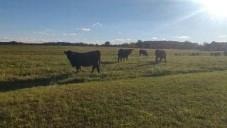By Richard Purdin
As the 2021 grazing season comes to a close, cattle producers are beginning to move cattle off the pasture into winter feeding lots or barns. This is also a great time of year to start planning for the next growing season. There are many factors that a cattle producer must consider these days when making plans for the 2022 grazing season. Two of factor that are hovering over cattle producers record books these days are, rising input cost and increasing land prices. With the recent improvement in feeder cattle and market cattle prices, many producers might be wondering if expanding their heard is worthwhile? With the increase in fertilizer prices neighboring landowners with hay land or idle grasslands might be considering cash leasing their land to that producer looking to expand. So how does one come up with a fair pasture rental price? Here are some options and consideration before entering a pasture lease agreement.

Have increased values of feed, cattle or fertilizer caused the value of rented pasture to change?
- Know each party’s responsibility- The two parties are the Livestock owner and landowner. There two parties should come to an agreement and understand their responsibilities. The landowner should cover the real estate taxes, cost of infrastructure (fence, barns, water) and their repairs, farm insurance. Livestock owners should calculate and budget what he or she can afford to pay in rent. Responsibilities such as fertilizing, mowing, and fixing damaged fence, should be reflected in the final rental agreement.
- Communicate and put it in writing- When discussing lease agreements make sure to record and write down rates, responsibilities, contract length, stocking rates, Disaster clause, and other specific discussions made during the negotiation process.
- What rental method works best for you? – There are several pasture rental methods that can be used but is each operation is set up differently, make sure to do your research evaluate which method works best for your farm operation.
- Animal Unit Method takes in account the average animal units time the average hay price on a per ton basis times the pasture quality factor. An animal Unit is equal to 1000 lbs. and pasture quality factors include
| Factor | Description |
| 0.12 | Unimproved, poor |
| 0.15 | Fair to good |
| 0.18 | Very good |
| 0.20 | Excellent |
| 0.22 | Lush legume pasture |
Ohio mixed grass hay prices for the last week of November ranged from $80-$150 per ton.
| Livestock type | Animal Unit |
| Mature Cow with unweaned calf at side or heifer two years of older | 1.25 |
| Bull, two years or older | 1.3 |
| Young cattle, one to two years old. | 0.8 |
| Weaned calves or yearlings | 0.6 |
As an example, let’s say your cow herd size is 1000 lbs. with a newly born calf weighing around 250 lbs. by her side and the current local hay market is $80/ ton for fair grass mixed hay which is equivalent to the pasture you are wanting to lease = 1.25 AU x $80/ton x .15 pasture quality factor = $ 15 per head per month. Factors such as current hay prices, pasture quality, and Animal units can have a direct effect on the pasture rental rate.
- Per acre rental method is an easy and common method used by producers. In 2020 USDA, NASS Ohio field office reported that the average pasture rental rate equaled $26/ acre ranging from $17/ acre in southeast Ohio to a high of 50.50/acre West Central Ohio. USDA NASS also reported current pastureland value price for Ohio equaled $3,370, find more details at https://www.nass.usda.gov .
- Pasture rental rates utilizing yields and Land capability from soil survey considers soil productivity based on average yield and the amount of forage or feed one animal unit for 30 days. The productivity and suitability of soil for grazing can be found in the Ohio soil survey. Local Soil and Water Conservation districts can provide county soil ratings or go to https://websoilsurvey.sc.egov.usda.gov/ to learn more about your soil suitability rating. Rental rates can be based on seasonal cost and grazing period cost. Season cost takes in account the price of hay per ton and equivalent pasture value x soil survey yield. Example – $80/ton hay value or 40/ton pasture x 2.5tons/acre rating = $100/ac. Grazing period cost takes in account pasture value x soil survey yield and grazing period indicated in the soil survey divided by animal unit days also indicated in the soil survey. Example $40/ton pasture value x 2.5tons/acre x 60 days of grazing/150 animal unit days = $40/ac
In Summary, there are many factors that can affect the price paid for pasture rental, from pasture quality, water availability, conditions of fence/facilities, current hay prices, and supply and demand. Before approaching the landowner producers need to have their ducks in a row, make sure to have a budget prepared also indicate incentives for the landowner to lease to you over other producers. Incentives such as good pasture management, rotational grazing practices, and good livestock husbandry are always good ways practices to highlight when negotiating. Last but not least communication is critical, 2022 has many unforeseen issues, don’t make a disgruntled landlord one of them due to miscommunication.
Source : osu.edu